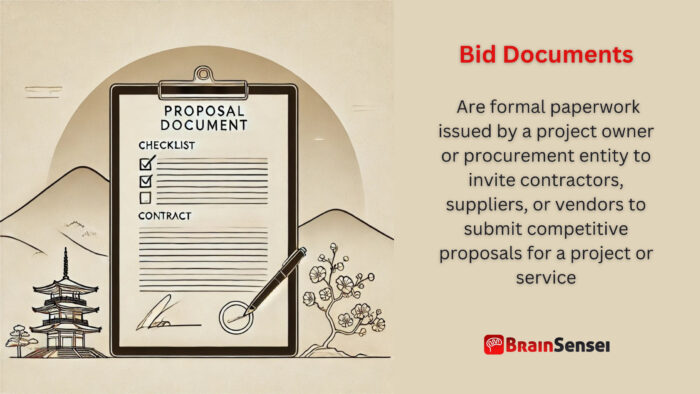
Bid Documents
What Are Bid Documents?
Bid documents are formal paperwork issued by a project owner or procurement entity to invite contractors, suppliers, or vendors to submit competitive proposals for a project or service. They outline the project’s requirements, scope, terms, and evaluation criteria, ensuring a transparent and structured bidding process.
Key Takeaways
- Bid documents facilitate fair competition by providing clear project expectations to all bidders.
- They standardize proposal evaluation, ensuring consistency in contractor selection.
- Essential for procurement and contracting, they protect both buyers and suppliers.
- Typically include technical specifications, pricing formats, and legal terms.
- They help mitigate risks by defining deliverables, compliance requirements, and contractual obligations.
Understanding Bid Documents
How They Work
Bid documents enable project owners to communicate requirements to potential contractors, establishing a transparent procurement process framework. These documents typically include:
- Invitation to Bid (ITB) or Request for Proposal (RFP): Announces the bidding opportunity and outlines submission guidelines.
- Scope of Work (SOW): Defines project objectives, deliverables, and performance expectations.
- Technical Specifications: Provides detailed requirements, such as materials, technology, and standards that contractors must meet.
- Bill of Quantities (BOQ): This document lists the required materials, labour, and other cost items to ensure accurate pricing.
- Terms and Conditions: Covers payment terms, dispute resolution, and legal obligations.
- Bid Forms: Standardized templates that ensure bidders submit structured proposals.
- Evaluation Criteria: Specifies how evaluators assess bids, ensuring an objective selection process.
Notes
- Completeness is crucial; missing documents can lead to bid rejection.
- Bid documents vary by industry, requiring customization for different projects.
- Legal compliance matters; contracts must adhere to procurement laws and regulations.
- Errors or ambiguities can lead to misinterpretation and project risks.
- Sealed bidding vs. negotiated bidding: The structure of bid documents may differ depending on the procurement method.
Related Terms
- Request for Proposal (RFP): A document inviting detailed proposals for complex projects requiring creative solutions.
- Request for Quotation (RFQ): A document seeking supplier price quotes for predefined goods or services.
- Request for Information (RFI): A preliminary inquiry sent to vendors to gather details before issuing an RFP or RFQ.
- Tender Document: A formal invitation for contractors to submit bids, usually used in government and large-scale projects.
- Procurement Process: The structured approach to acquiring goods or services, including bid preparation, evaluation, and contract awarding.
- Bid Evaluation: Reviewing and scoring submitted bids based on predefined criteria.
Examples of Bid Documents in Different Industries
Construction Industry
A government agency issues bid documents for a new highway project. The package includes an ITB, technical specifications for materials, safety regulations, BOQ, and an evaluation matrix to assess bids. Contractors submit detailed proposals, and the agency selects the most cost-effective and compliant bid. The project undergoes multiple evaluation phases, including financial feasibility, contractor experience, and environmental impact assessments. Once the winning bid is selected, contract negotiations commence to finalize legal and logistical details. During execution, the bid documents are a reference for quality control, project milestones, and compliance verification.
IT & Software Development
A multinational corporation seeks proposals for a cybersecurity solution. The bid documents include an RFP detailing security requirements, system compatibility, service level agreements (SLAs), and a pricing structure. Vendors submit proposals outlining their technology stack, implementation timeline, and maintenance support. The corporation evaluates the bids based on security effectiveness, cost efficiency, vendor reliability, and regulatory compliance. After awarding the contract, the bid documents guide the implementation process, ensuring the selected vendor adheres to agreed-upon security protocols, performance benchmarks, and compliance with data protection regulations.
Healthcare Sector
A hospital procurement team issues a bid document for medical equipment procurement. The package includes RFQ forms specifying technical features, warranty requirements, compliance with medical regulations, and vendor qualifications. Suppliers submit their quotes, and the hospital selects a vendor based on cost and product quality. In this case, the bid documents also incorporate maintenance agreements, supply chain reliability assessments, and post-installation support clauses. The hospital conducts rigorous testing and compliance checks before finalizing the contract. The bid documents are the foundation for future warranty claims, maintenance schedules, and vendor accountability.
Renewable Energy Industry
A European energy firm invites bids for a solar farm installation. The bid documents include an ITB, environmental impact assessments, project timeline expectations, and warranty requirements. The firm selects a contractor based on sustainability measures and pricing. The bid documents also outline incentive programs, regulatory approvals, and performance guarantees. After awarding the contract, the project team uses the bid package to track project milestones, ensuring compliance with renewable energy regulations and long-term operational efficiency.
Smart City Initiative
A metropolitan government in Asia releases bid documents for an innovative city traffic management system. The package includes an RFP specifying IoT integration, AI-driven analytics, cybersecurity measures, and vendor support. Tech firms compete to offer the most innovative and cost-effective solutions. The documents specify interoperability with existing infrastructure, data privacy regulations, and performance benchmarks. The winning contractor follows the bid documents as a roadmap for system implementation, testing, and scalability planning.
Use Cases of Bid Documents
North America (Infrastructure Development)
A state transportation department releases bid documents for a major bridge construction project. The bid documents include an ITB outlining eligibility criteria, technical specifications, and contract terms. Several construction firms submit detailed proposals, which are reviewed based on experience, financial stability, and technical capabilities. The department also evaluates environmental impact compliance and cost-effectiveness. After a rigorous selection process, the selection committee awards a contract to the most qualified bidder. The bid documents serve as a legally binding framework throughout the project, ensuring compliance with safety standards, budget control, and project deadlines.
Europe (Renewable Energy Project)
A European energy company seeks bids for a large-scale offshore wind farm installation. The bid documents include an RFP specifying performance requirements, environmental impact mitigation strategies, and grid connection specifications. Interested contractors submit proposals detailing their technology, construction methodologies, and risk mitigation plans. The company evaluates bids based on sustainability criteria, cost projections, and experience with similar projects. After selection, the winning bidder follows the detailed bid documents as a reference for project execution, compliance monitoring, and final delivery assessments. This structured approach ensures project viability, adherence to renewable energy incentives, and regulatory approval.
Asia (Smart City Initiative)
An Asian metropolitan government issues bid documents for an advanced traffic management system as part of an innovative city initiative. The bid package includes an ITB, technical blueprints, cybersecurity compliance requirements, and AI-driven analytics integration guidelines. Competing technology firms submit their proposals, showcasing AI capabilities, real-time monitoring solutions, and system scalability. After thorough evaluation, the government selects a contractor based on innovation, security robustness, and long-term maintenance capabilities. The documents remain central to implementation, and they help project teams meet milestones, uphold data privacy regulations, and seamlessly integrate the system with existing infrastructure.
Africa (Healthcare Facility Expansion)
An African public health agency releases bid documents for expanding a regional hospital. The procurement team includes an RFP detailing infrastructure upgrades, medical equipment procurement, and staffing requirements. Interested bidders submit proposals outlining construction schedules, compliance with medical regulations, and financial feasibility plans. The government evaluates bids based on cost efficiency, adherence to health codes, and contractor experience in similar projects. Once a winning bidder is selected, the bid documents guide the expansion project, ensuring accountability in budget use, timely delivery, and adherence to international healthcare facility standards.
Middle East (Defense Contracting)
A defence ministry in the Middle East seeks contractors for a new military logistics hub. The bid documents contain highly classified security protocols, infrastructure design requirements, and performance metrics for logistical efficiency. Eligible defence contractors submit bids detailing supply chain management capabilities, construction techniques, and security compliance measures. A stringent evaluation process ensures that the awarded contract meets national security interests, operational efficiency benchmarks, and cost management goals. The bid documents are an essential guide for project execution, ensuring confidentiality, compliance with defence regulations, and high-performance operational capabilities.
Best Practices for Creating Bid Documents
Bid documents should be clear, comprehensive, and legally sound to avoid disputes and project delays. Adequate document preparation involves several key practices that ensure efficiency and fairness in the procurement process.
Ensure Clarity and Completeness
One of the most common issues in bid documents is ambiguity. Defining the project scope, deliverables, and evaluation criteria minimizes confusion and potential disputes. Ensure that:
- The Scope of Work (SOW) is detailed and includes specifications, timelines, and performance expectations.
- Evaluation criteria are well-defined to prevent subjective assessments.
- The document clearly states legal terms and conditions, protecting both parties.
Use Standardized Templates for all Bid Documents
Standardized bid document templates improve efficiency and ensure compliance with industry regulations. Organizations can:
- Adopt industry-specific formats that align with procurement best practices.
- Include checklists to ensure all required elements are present.
- Utilize software solutions to streamline document preparation and submission.
Engage Legal and Compliance Teams
Legal experts should review bid documents before issuing them to avoid compliance risks and ensure enforceability. Key areas to review include:
- Contract terms and conditions, including dispute resolution mechanisms.
- Regulatory requirements related to labour laws, environmental compliance, and safety.
- Confidentiality clauses to protect sensitive project details.
Conduct Pre-Bid Meetings
Hosting pre-bid meetings with potential bidders allows for clarifications and ensures alignment on project expectations. During these meetings:
- Address bidder concerns regarding the scope, timelines, or specifications.
- Provide written responses to common questions in a Bid Addendum.
- Encourage an open dialogue to refine requirements based on bidder expertise.
Establish a Transparent Evaluation Process
A well-defined evaluation process reduces bias and improves selection fairness. Best practices include:
- Evaluators will use a weighted scoring system to assess bids objectively.
- Ensuring a diverse evaluation committee to bring varied perspectives.
- Keeping detailed records of the evaluation process for transparency and audits.
Ensure Competitive and Realistic Pricing
Price realism assessments help avoid underbidding, which can lead to project failures. Effective pricing strategies include:
- Conducting market research to set a fair and reasonable price range.
- Requiring bidders to submit cost breakdowns for transparency.
- Implementing benchmarking practices to compare bid prices against industry standards.
Plan for Post-Bid Activities
After awarding a contract, bid documents remain referenced throughout the project lifecycle. Ensuring effective post-bid management includes:
- Regular compliance checks to ensure the contractor adheres to bid specifications.
- Implementing performance reviews based on contractual milestones.
- Establishing dispute resolution mechanisms to address potential conflicts efficiently.
Continuous Improvement and Lessons Learned
Organizations should assess past bid processes to improve future procurement practices. Conducting post-project evaluations helps to:
- Identify common pitfalls in bid documentation.
- Refine evaluation methods to enhance fairness.
- Improve communication strategies with bidders to reduce misunderstandings.
Conclusion: By implementing these best practices, organizations can ensure their documents are structured, transparent, and legally sound. Clarity in requirements, legal compliance, standardized processes, and open communication contribute to a fair and efficient bidding process. Organizations that consistently refine their documentation practices will achieve better project outcomes, improve vendor relationships, and minimize legal risks.
Bid Documents: Common Mistakes and Issues
Lack of Clarity in Requirements
One of the most prevalent mistakes in bid documents is failing to define project requirements clearly. Vague descriptions can lead to misinterpretations, resulting in bids that do not align with the project’s needs. Without precise technical specifications, scope of work, and deliverables, bidders may submit proposals that fail to meet expectations, causing project delays and cost overruns.
Poorly Defined Evaluation Criteria
Bid documents should provide transparent evaluation criteria to ensure a fair selection process. A common issue arises when bid evaluation methods are ambiguous or too subjective. For example, suppose criteria such as experience, financial stability, and technical expertise are not well-outlined. In that case, decision-makers may struggle to assess competing proposals fairly, potentially leading to biased or inconsistent contract awards.
Overly Complex or Unnecessarily Lengthy Bid Documents
Some bid documents contain excessive legal jargon, unnecessary technical details, or redundant sections, making them difficult for bidders to comprehend. Overcomplicated documents may discourage qualified vendors from submitting bids, reducing competition and increasing the risk of selecting a suboptimal contractor. Streamlining bid documents while retaining necessary details improves clarity and accessibility for all participants.
Unrealistic Budget and Timeline Expectations
Another common issue is setting unrealistic budgetary constraints or project deadlines that do not align with industry norms. Bidders may either overpromise, leading to project delays and cost overruns, or choose not to participate due to impractical expectations. Conducting thorough market research before finalizing bid documents helps ensure that cost estimates and project timelines are feasible and competitive.
Failure to Address Legal and Compliance Issues
Neglecting legal and compliance requirements in bid documents can result in significant risks, including contract disputes, regulatory violations, and financial penalties. Contracts should explicitly define obligations related to labour laws, environmental compliance, safety standards, and intellectual property rights. Consulting legal experts during document preparation mitigates these risks.
Lack of a Robust Q&A or Pre-Bid Process
Potential bidders often have questions about bid documents, and failing to provide opportunities for clarification can lead to confusion and non-compliant submissions. Establishing a structured pre-bid meeting or a formal Q&A process allows bidders to seek necessary clarifications and ensures all participants understand project requirements and expectations.
Not Considering Risk Management Strategies
Bid documents should address risk allocation to protect the project owner and contractors. Omitting contingency plans for unforeseen circumstances—such as supply chain disruptions, labour shortages, or economic fluctuations—can lead to disputes and project delays. Clearly defining risk-sharing mechanisms in bid contracts helps mitigate uncertainties.
Poor Communication and Distribution Channels
Ineffective communication during the bidding process can lead to missed deadlines and reduced participation. Failure to adequately distribute bid documents through appropriate procurement channels prevents timely notifications to potential vendors. Leveraging digital procurement platforms, government portals, and industry networks ensures broad distribution and higher-quality submissions.
Failing to Define Performance Monitoring and Contract Compliance
Bid documents should outline project execution expectations and post-contract performance monitoring. Without clear metrics for tracking contractor performance, accountability becomes challenging. Including compliance check mechanisms, periodic evaluation criteria, and penalties for non-compliance ensures that contractors adhere to their contractual obligations.
Conclusion: Avoiding these common mistakes in bid documentation enhances transparency, encourages greater competition, and minimizes risks associated with procurement. Organizations can improve the efficiency and effectiveness of their bidding process by ensuring clarity in requirements, setting realistic expectations, defining fair evaluation criteria, and addressing legal compliance. Proactive bid management strategies and continuous refinement of procurement practices contribute to successful project outcomes and long-term vendor relationships.
Bid Documents: Frequently Asked Questions (FAQs)
What is the purpose of bid documents?
Bid documents standardize the procurement process by outlining project requirements, submission guidelines, and evaluation criteria, ensuring fair competition and contract clarity.
How do bid documents differ from contracts?
Bid documents invite proposals, whereas contracts formalize the agreement between the selected bidder and the project owner.
What happens if bid documents are incomplete?
Incomplete bid documents can lead to bidder confusion, non-compliant proposals, and potential legal disputes.
Are bid documents legally binding?
While bid documents set the framework for procurement, signing a contract with the selected bidder makes them legally binding.
How can organizations improve their bid documents?
Using standardized templates, defining clear evaluation criteria, and ensuring legal compliance can enhance the effectiveness of bid documents.
Additional Resources
- How to Make a Request for Proposal (RFP): Example & Template Included
- How to Write an Impactful RFP: Tips, Templates, and Real-World RFP Examples
Preparing for a PMI certification?
- Exam Prep Courses: PMP®, CAPM®, and PMI-ACP®
- Exam Simulators: PMP®, CAPM®, PMI-ACP®, PMI-PBA®, PMI-RMP®, PMI-SP®, PgMP®, and PfMP®
- Professional Development Units (PDUs): 15, 30, and 60 PDU Bundles



